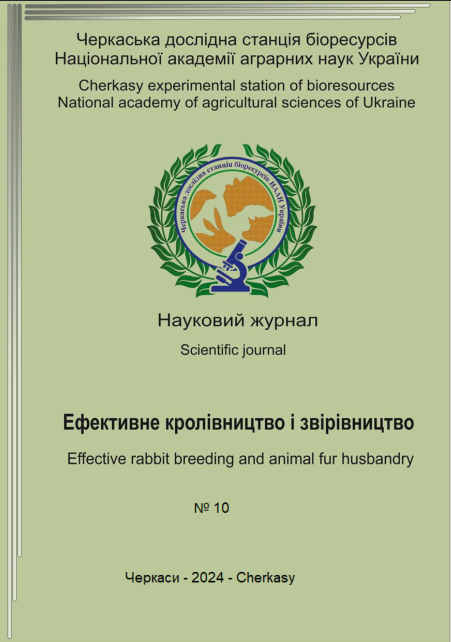THE INFLUENCE OF ZOOHYGIENIC CONDITIONS ON FERTILITY AND FUR QUALITY OF FARMED CHINCHILLA
DOI:
https://doi.org/10.37617/2708-0617.2024.10.31-41Keywords:
chinchillas, zoohygienic conditions, microclimate, fertility, fur qualityAbstract
The aim of this study was to investigate the impact of zoohygienic conditions on selected production indicators of chinchillas, including fertility and fur quality. The research was conducted on a chinchilla farm in Myślenice (Poland), analyzing two housing units (Room A and Room B) during two periods: winter and spring. Measurements included temperature, humidity, air movement, gas concentration, and lighting within cages located at different levels. The results indicate that temperature and humidity were critical factors influencing productivity and fur quality. During the winter, lower fertility and poorer fur quality were observed, particularly in the colder housing unit B, where the average temperature was 17°C. Humidity levels in winter were also low (19–37%), negatively affecting health and fur quality. Spring conditions were more favorable, with higher temperatures (18.6°C in housing unit A) and humidity levels, leading to improved production indicators. Lighting, especially on the upper cage levels, also positively affected fertility. Higher light intensity in housing unit A contributed to better reproductive outcomes. In summary, optimizing the microclimate in farm housing, particularly with regard to temperature, humidity, and lighting, is crucial for enhancing production efficiency on chinchilla farms.
References
Spotorno A.E., Zuleta C.A., Valladares J.P., Deane A.L., Jimenez J.E. (2004) Chinchilla laniger in Mammalian species. ASM, 758, 1-9.
Valladares P., Zuleta C., Spotorno O.Á. (2014) Chinchilla lanigera (Molina 1782) and C. chinchilla (Lichtenstein 1830): review of their distribution and new findings. https://repositorio.uchile.cl/handle/2250/147330
Roach N., Kennerley R. (2016) Chinchilla lanigera (errata version published in 2017). The IUCN Red List of Threatened Species 2016, e.T4652A117975205. https://dx.doi.org/10.2305/IUCN.UK.2016-2.RLTS.T4652A22190974.en
Bidlingmaier T.C. (1937) Notes on the genus Chinchilla. J. Mammal. 18, 159-163. https://doi.org/10.2307/1374461
Valladares F.P, Spotorno O.Á, Zuleta R.C. (2014) Natural history of the Chinchilla genus (Bennett 1829): Considerations of their ecology, taxonomy and conservation status. Gayana (Concepción). 78, 135-143. https://doi.org/10.4067/S0717-65382014000200008
SCAHAW. (2001) Scientific Committe on Animal Health and Animal Welfare, 2001. The Welfare of Animals Kept for Fur Production. European Commission. https://food.ec.europa.eu/system/files/2020-12/sci-com_scah_out67_en.pdf
Chernova O.F., Zherebtsova O.V. (2023) Architecture of vibrissae in eight rodent species of Ctenohystrica (Rodentia): A comparative SEM study. Zoologischer Anzeiger; 307, 54-69. https://doi.org/10.1016/j.jcz.2023.09.004
Mans C., Donnelly T.M. (2021) Chapter 22: Chinchillas. In: 4th. Ferrets, rabbits, and rodents: Clinical medicine and surgery. Elsevier. St. Louis, Missouri. 298-322.
Jiménez, J.E. (1996) The extirpation and current status of wild chinchillas Chinchilla lanigera and C. brevicaudata. Biol. Conserv., 77, 1-6. https://doi.org/10.1016/0006-3207 (95) 00116-6
Parker, W.D. (1975) Modern chinchilla farming. Borden Publishing Co., Alhambra, California.
Dzierżanowska-Góryń, D.; Kaleta, T.; Kowalczyk, M. (2005) The behaviour and an activity of chinchilla (Chinchilla lanigera) kept under laboratory conditions. In XIIth International Congress in Animal Hygiene (ISAH), Warszawa, Poland, Warsaw Agricultural University. https://www.isah-soc.org/userfiles/downloads/proceedings/2005/sections/109_vol_2.pdf
Łapiński, S.; Niedbała, P.; Markowska, K.; Rutkowska, A.; Lis, M.W. (2023) The effects of age, size, and cage complexity on the behaviour of farmed female chinchillas (Chinchilla lanigera). Sci. Rep., 13, 6108. https://doi.org/10.1038/s41598-023-32516-5
CoE. (1999) Standing Committee of the European Convention for the Protection of Animals Kept for Farming Purposes (T-AP). Recommendation Concerning Fur Animals, Adopted by the Standing Committee on 22 June 1999. https://www.coe.int/t/e/legal_affairs/legal_co-operation/biological_safety_and_use_of_animals/farming/rec%20fur%20animals%20e%201999.asp
Barabasz B., Łapiński S. (2008) Growth rate of sucking chinchilla pups and lactating performance of their dams. Animal Science Papers and Reports, 3, 227-234.
Łapiński, S.; Lis, M.W.; Wójcik, A.; Migdał, Ł; Guja, I. (2014) Analysis of factors increasing the probability of fur chewing in chinchilla (Chinchilla lanigera) raised under farm conditions. Ann. Anim. Sci., 14, 189–195. https://doi.org/10.2478/aoas-2013-0067
Łapiński, S.; Orel, J.; Niedbała, P.; Kucharska, W.; Jakubowska, M.; Lisowska-Lis, A.; Tombarkiewicz, B.; Lis, M.W. (2020) Infrared Thermography as an Indicator of Heat Loss in Fur-Chewing Chinchillas (Chinchilla lanigera). J. Appl. Anim. Welf. Sci., 23, 338-347. https://doi.org/10.1080/10888705.2019.1614924
Sulik M., Seremak B., Bielińska A., Mieleńczuk G. (2001) Intensywność użytkowania rozpłodowego samic szynszyli w wybranej fermie na Pomorzu Zachodnim. Zeszyty Naukowe Polskie Towarzystwo Zootechniczne Warszawa, 58, 73-78.
Barabasz B. (2008) Szynszyle Chów fermowy. PWRiL, Warszawa.
Sulik M., Felska L. (2000) Analiza wad skór szynszylowych. Zeszyty Naukowe Polskie Towarzystwo Zootechniczne Warszawa, 53, 205-214.
KCHZ. (2012) Wzorzec oceny fenotypu szynszyli. Krajowe Centrum Hodowli Zwierząt, Warszawa.
Jarosz S., Rżewska E. (1996) Szynszyle, chów i hodowla. Państwowe Wydawnictwo Rolnicze i Leśne, Warszawa.
Nowak M. (1995) Jak urządzić fermę szynszyli. Biuletyn Informacyjny dla Hodowców Szynszyli, 1.
Hoefer H.L. (1994) Chinchillas. Veterinary Clinics of North America: Small Animal Practice. 24, 103-111. https://doi.org/10.1016/S0195-5616 (94) 50005-6
Felska L. (19990 Warunki zoohigieniczne na fermie szynszyli. Przegląd Hodowlany, 7, 24-26.
Neira N.R., Garcia F.X., Scheu R. (1989) Analisis descriptivo del comportamiento reproductivo y de crecimiento de chinchillas (Chinchilla laniger Grey) en confinamiento. Avances en Produccion Animal, 14, 109-119.


